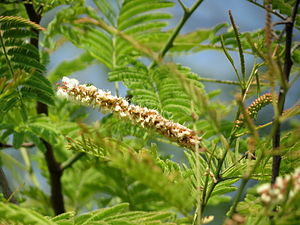Note: This is a project under development. The articles on this wiki are just being initiated and broadly incomplete. You can Help creating new pages.
Acacia ferruginea - Arimedah
Acacia ferruginea is the botanical name of Arimedah. This tree played an important role in the time of Mahabharat. Pandavas hide their weapons on this tree while they leaving for "Agnathavasa". Banni tree is worshipped in Hinduism. Especially in south India this tree is worshipped in the time Dussehra / Vavaratri. Vijayadashmi day this tree is worishpped by The Royal Family of Mysore. "Acacia ferruginea" and Khadira both are same family.
Uses
migraines, headaches, vomiting, piles, burning sensation, perspiration problems, burning sensation in the vagina.
Parts Used
Chemical Composition
Atisine, Aconitine, Atisenol, Atidine, Hetisine, Hetisinone, Banzolheteratisine, Histidine, F-dihydroatisine, Heteratisine and Several diterpene alkaloids such aheterophyllin, heterophyllisin, heterophyllidine, and hetidine.[1]
Common names
| Language | Common name |
|---|---|
| Kannada | banni, banni mara, banue, kiri banni |
| Hindi | kaigar, kalgar, kingore |
| Malayalam | karivelam |
| Tamil | cimai-velvel, Chimaivelvel, Karambai |
| Telugu | anachandra, anasandra, inupa tumma |
| Marathi | NA |
| Gujarathi | NA |
| Punjabi | NA |
| Kashmiri | NA |
| Sanskrit | arimedah, brahmashalya, dvijapriya |
| English |
Habit
Identification
Leaf
| Kind | Shape | Feature |
|---|---|---|
| Bipinnate | Elliptic | Leaf Apex is Aubacute, Leaf Base is Oblique and Leaf Margin is Ciliate |
.[2]
Flower
| Type | Size | Color and composition | Stamen | More information |
|---|---|---|---|---|
| Unisexual | 2-4cm long | cream to yellow | 10 | Flowering from August-September and Two to three in clusters of terminal panicles |
Fruit
| Type | Size | Mass | Appearance | Seeds | More information |
|---|---|---|---|---|---|
| 7–10 mm (0.28–0.4 in.) long pome | s | {{{6}}} |
Other features
List of Ayurvedic medicine in which the herb is used
- Vishatinduka Taila as root juice extract
Where to get the saplings
Mode of Propagation
How to plant/cultivate
A plant of drier areas in the tropics where it can be found at elevations from 150 - 1,500 metres.[3]
Commonly seen growing in areas
Photo Gallery
References
External Links
- Pages that are stubs
- Ayurvedic Herbs known to be helpful to treat migraines
- Ayurvedic Herbs known to be helpful to treat headaches
- Ayurvedic Herbs known to be helpful to treat vomiting
- Ayurvedic Herbs known to be helpful to treat piles
- Ayurvedic Herbs known to be helpful to treat burning sensation
- Ayurvedic Herbs known to be helpful to treat perspiration problems
- Ayurvedic Herbs known to be helpful to treat burning sensation in the vagina
- Herbs with stem used in medicine
- Herbs with bark used in medicine
- Herbs with fruit used in medicine
- Herbs with common name in Kannada
- Herbs with common name in Hindi
- Herbs with common name in Malayalam
- Herbs with common name in Tamil
- Herbs with common name in Telugu
- Herbs with common name in Sanskrit
- Habit - tree
- Index of Plants which can be propagated by Seeds
- Herbs that are commonly seen in the region of Trophical climate
- Herbs




